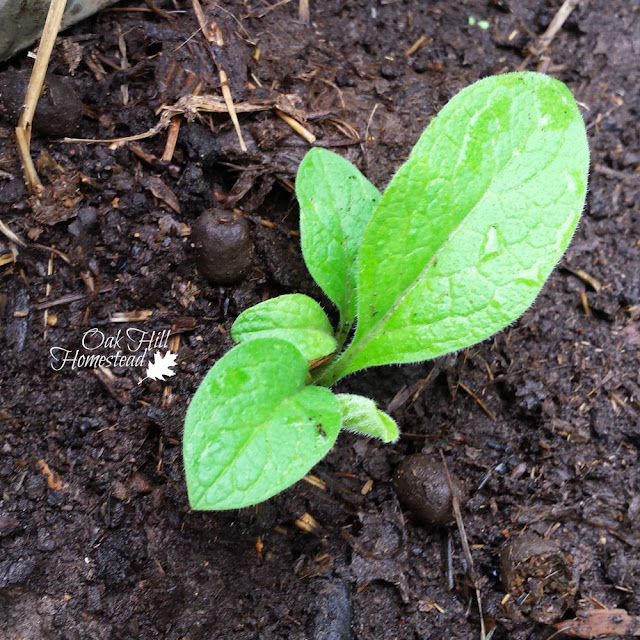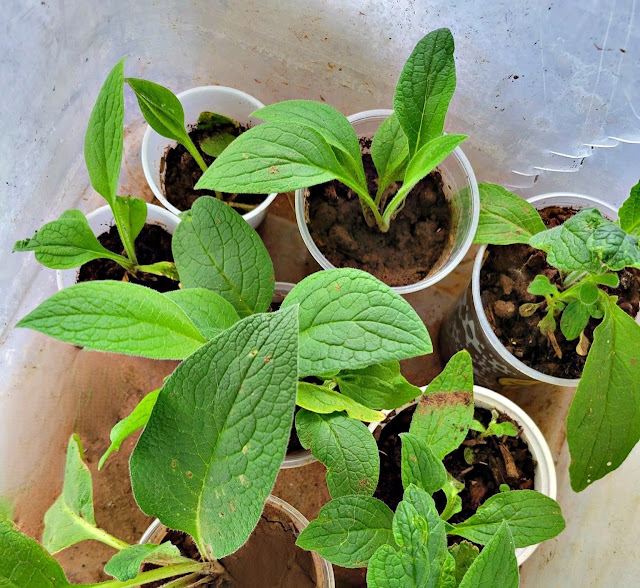Once you decide to include this powerful plant in your garden, you'll need to know how to plant and grow comfrey. It's easy, and almost anyone can grow comfrey successfully. Learn how to plant comfrey from root cuttings and how to grow this prolific, beneficial herb.
How to grow comfrey plants
Comfrey is one of the easiest plants to grow, and you can plant it any time as long as the ground isn't frozen.
A perennial plant, comfrey will thrive best in zones 4-8 (US gardening zones), can grow in nearly any soil conditions and is content whether its location is sunny or partially shady.
What is comfrey?
Comfrey is a perennial herb that dies back in the winter and grows again in the spring. It prefers well-drained, loamy soil with a neutral pH, but it isn't very picky, and does well in full sun or in partial shade.
My mature comfrey plants are almost 3 feet in diameter, and almost as tall as they are wide. They flower each spring, sending up stalks of bell-shaped purple flowers, but the flowers can also be white, pink or blue.
These pretty flowers attract pollinators such as honeybees and bumblebees.
Why should you grow comfrey? Check out these 5 uses of comfrey and the reasons to grow it . I'm sure you'll agree that it's a great addition to your garden.
Russian comfrey vs true comfrey
I'm growing the strain of comfrey known as Russian Bocking No. 14, Symphytum x uplandicum.
Russian comfrey doesn't grow from seed, it has to be grown from root cuttings.
Is comfrey invasive?
True comfrey or common comfrey, which grows from seed, is considered to be invasive. The seeds scatter everywhere and the plants are hard to get rid of once they are established.
However, the Bocking 14 strain of comfrey produces sterile seeds that won't germinate and grow. This variety is propagated by the roots, either root cuttings, crowns with roots, or divided plants. This gives you more control.
I have found a few escapees though. I had a large pot of comfrey that was growing in a corner of our yard. In late summer I moved the pot to mow the grass around it, and as I moved it I broke the roots that had grown out of the drainage holes of the pot.
Those roots that were left behind grew into new plants the following spring.
It was a simple matter to dig them up when they were young and move them into small pots of their own, but this is a word of warning - they can escape if you're not careful. (I dug up and potted 15 of these small plants, left behind by just one potted comfrey plant in a very large pot.)
Also, don't use a rototiller in your comfrey patch, for the same reason: it will cut the roots into pieces and you'll have little comfrey plants everywhere.
How to grow comfrey
Comfrey is amazingly easy to grow. Just give it plenty of room so it won't encroach on other plants as it grows in size.
Mine thrive in part shade as well as in full sun. You'll need to water your plant more often in hot weather, especially if it is growing in full sun.
Your comfrey plant will tell you when it's thirsty and needs additional water. The leaves visibly wilt when it's parched.
Keep an eye on your plants between waterings and give it water right away if you notice the plant's leaves are wilting.
In extreme cases, the wilted leaves might die back, but new leaves will replace them if you've watered it in time.
Keep reading to learn how to plant comfrey root cuttings and plant divisions.
Propagating comfrey plants
If you want to propagate comfrey plants on purpose, it's almost as easy as doing it by accident, like I did when I moved that pot of comfrey.
Dig up around the outer edge of your established plant, and cut off a root or two from below the surface of the soil. The root should be at least as thick as a #2 pencil and about 3-4 inches long for best results.
How to grow comfrey from root cuttings
Bury the root cuttings in the soil about 2-4" deep, laid horizontally. Water the root cuttings well and keep the soil evenly moist - not soggy - until the leaves are visible above the ground.
Comfrey can be planted any time during the growing season, but during the spring is best.
How to plant comfrey plants and plant divisions
You can also divide an established plant by dividing it in half with a shovel, then plant each piece in a pot or back in your garden.

How long does it take for comfrey to grow?
Root cuttings can take up to 40 days or so to sprout and for the leaves to grow above the soil.
They are busy growing their roots below ground before they send up leaves, so don't disturb your new plants during this time, just be patient.
Growing comfrey in containers
Yes, comfrey can grow in pots and containers. They need a large, tall pot and well-draining soil. The plant won't grow as large as it will when grown in the ground or in a raised bed, and might not flower.
You'll need to keep an eye on the bottom of the pot, because the roots will try to grow out through the drainage holes and into the ground below. Keep those roots trimmed to prevent "escape."
Comfrey doesn't really like growing in containers - even though it will if if has to. It prefers to thrust its roots deep into the soil. Those long roots bring up minerals to ground level, which makes them accessible to shallow-rooted plants and is one of the advantages of growing this plant.
So I suggest that you only grow them in containers temporarily, and plant them in the ground when you are able.
Comfrey can thrive just about everywhere
Comfrey is a very resilient plant, and I have a story to prove it.
I ordered root cuttings of Russian Bocking 14 comfrey online, but I had to wait until the seller was able to dig up and mail the roots. Their northern spring was much later than my Oklahoma spring.
By the time my box of root cuttings arrived, I was frantically getting ready for all of our children, their spouses and our grandchildren to descend on us for a family wedding, so I set the box down and...
...two months later I remembered the comfrey!
I opened the box, expecting to find dried-out roots that I desperately hoped would revive if I soaked them in water overnight before planting.
The roots were packed in a plastic shopping bag which was wound tight and taped shut. Another bag inside that one was also tightly wrapped and taped. And inside that one I found a packet of still-damp newspaper enclosing the large brown roots, with white shoots growing from the ends.
Those roots had thrived inside their damp, dark package for two months and were full of life and vitality, and they grew as if they had been freshly dug up. Those first plants are the ancestors of my current plants.
Yes, comfrey is a very resilient plant. In my experience, the two biggest threats to comfrey are:
- not enough water
- being eaten to the ground by cows
Every garden needs at least one comfrey plant! Learn how you can use it in this post 5 Uses for Comfrey.


















